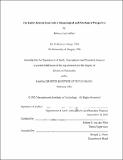The earth's interior from both a seismological and petrological perspective
Author(s)
Saltzer, Rebecca Lee
DownloadFull printable version (2.019Mb)
Other Contributors
Massachusetts Institute of Technology. Dept. of Earth, Atmospheric, and Planetary Sciences.
Advisor
Robert D. van der Hilst.
Terms of use
Metadata
Show full item recordAbstract
Shear-wave splitting measurements of teleseismic shear waves, such as SKS, have been used to estimate the amount and direction of upper-mantle anisotropy worldwide. One of the basic assumptions in making these measurements is that the anisotropy is confined to a single, homogeneous layer. In this thesis, I use both numerical and analytical modeling to examine the validity of this assumption. I find that variability in the orientation of anisotropy with depth causes observable effects, such as frequency dependence in the apparent splitting parameters, and that the measured fast-axis direction is consistently different than the average of the medium. A separate focus of this thesis is how spatial associations between minerals in a thin-section can be used to infer the evolutionary pressure-temperature history of a rock. I present a new method for textural analysis that uses digital images obtained with the electron microprobe. This method is used to characterize nine mantle xenoliths erupted from kimberlite pipes in South Africa and to test whether the pyroxenes are spatially correlated with the garnets. The observed associations can be explained by a model in which harzburgitic residues are produced by large extents of partial melting at shallow depths (-60-90 km) and high temperatures (1300-1400ʻ C) and are then subsequently dragged down to greater depths where garnet and clinopyroxene exsolve, perhaps in an Archean subduction zone. The third focus of this thesis is on the seismological evidence for compositional heterogeneity in the lower mantle. Using reprocessed ISC data, I compare P and S wave tomographic models and find systematic differences between regions that have undergone subduction in the last 120 million years and those that have not below -1500 km. (cont.) This global study is followed up with a regional study using higher-quality P and S wave differential traveltimes. Beginning at depths of -1000 km down and continuing down to the core-mantle boundary I find variability in Poisson's ratio that is greater than what would be expected by temperature variations alone. A simple explanation is that the variability includes a contribution from compositional effects, such as 2% variability in iron from one region to another.
Description
Thesis (Ph.D.)--Massachusetts Institute of Technology, Dept. of Earth, Atmospheric, and Planetary Sciences, 2002. This electronic version was submitted by the student author. The certified thesis is available in the Institute Archives and Special Collections. Includes bibliographical references (p. 111-122).
Date issued
2002Department
Massachusetts Institute of Technology. Department of Earth, Atmospheric, and Planetary SciencesPublisher
Massachusetts Institute of Technology
Keywords
Earth, Atmospheric, and Planetary Sciences.